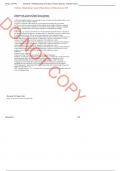Exam (elaborations)
Test Bank - Pathophysiology-Concepts of Human Disease, 1st Edition (Sorenson, 2019), Chapter 1-53 | All Chapters
- Course
- Institution
- Book
Test Bank - Pathophysiology-Concepts of Human Disease, 1st Edition (Sorenson, 2019), Chapter 1-53 | All Chapters
[Show more]




